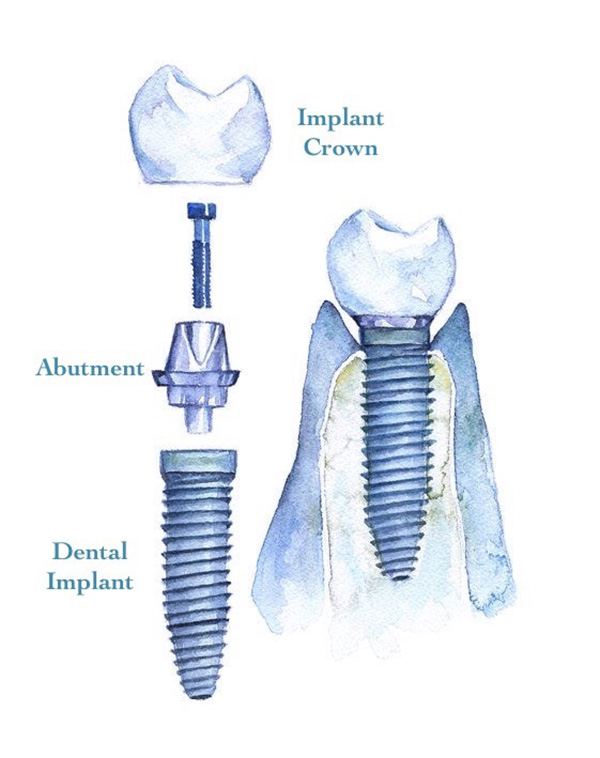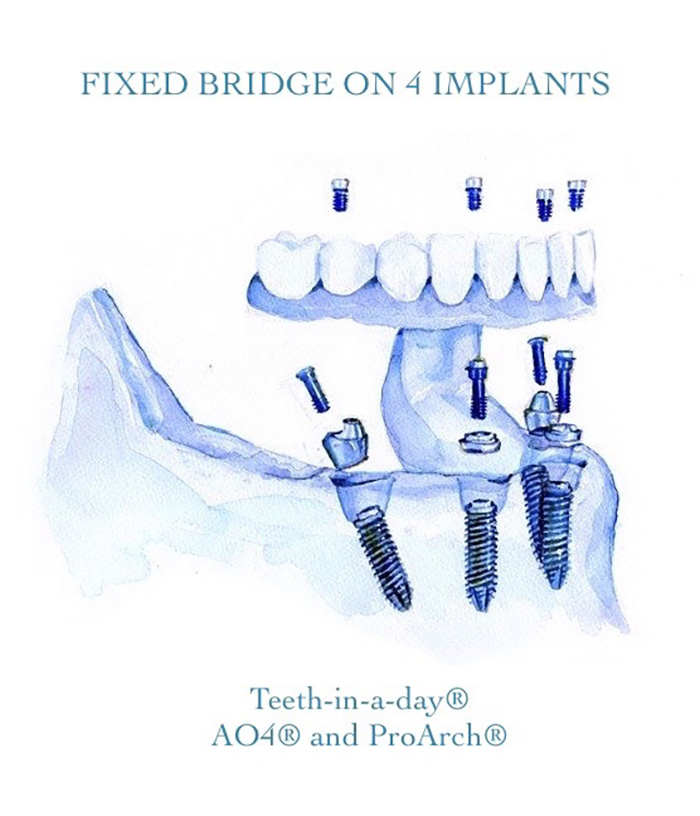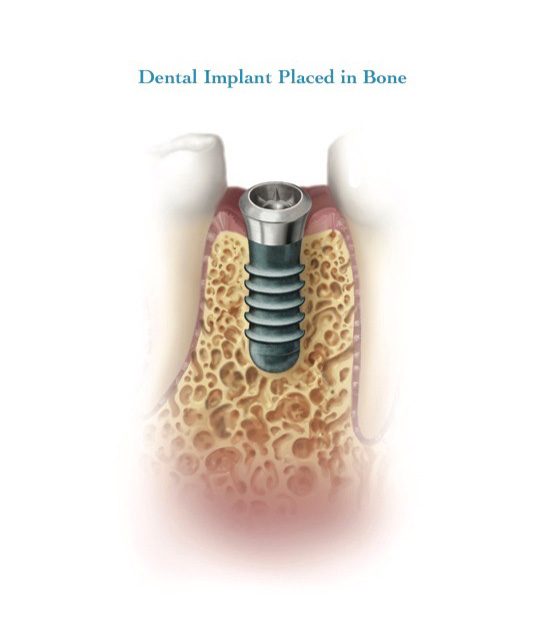“No one should [have to] die with their teeth in a glass of water beside their bed.”
-- Per-Ingvar Brånemark
What Are Dental Implants?
Dental implants are the closest you can get to healthy, natural teeth. They allow you to live the way you want to – confidently eating, smiling, laughing, talking and enjoying all of your everyday activities without worrying about your teeth.
A dental implant is essentially a surgically placed substitute for a natural root. Each implant is placed into a surgically prepared socket at the precise location of the intended tooth. They become a sturdy base for supporting one or more artificial teeth, called crowns. This component, which is made from titanium, can then provide the foundation for long-term support of crowns, bridges or dentures.
Dental implants are today's state-of-the-art and best alternative to your natural teeth. They offer a permanent and secure solution for replacing one or more teeth. They are used as anchors or support for traditional forms of dentistry, such as crowns, bridges or dentures.
A connector – known as an abutment – is placed on top of the dental implant to hold and support your crowns. The crowns are custom-made to match your natural teeth and fit your mouth. Modern dental implants have been used successfully for over 30 years. They are the strongest devices available to support replacement teeth. Even better, they allow these new teeth to feel, look, and function naturally.
When performed by a trained and experienced dental implant dentist, dental implant surgery is one of the safest and most predictable procedures in dentistry. Dental implants are the only dental restoration option that preserves natural bone, actually helping to stimulate bone growth.

Why do so many people prefer dental implants?
Dental implants are the most natural looking and natural feeling replacement for missing teeth. Unlike other tooth replacement options, dental implants don’t slip or click when you talk, laugh or eat. And they help keep your jawbone healthy so that your facial structure stays intact.
How much do dental implants cost?
No two patients or their customized dental implants treatments are exactly alike, so the cost, as well as the number of appointments required and procedures performed, will vary depending on your particular needs. I recommend consulting an AAID-credentialed dental implant expert who can conduct a comprehensive examination and evaluate the necessary diagnostics to best determine your needs and the associated fees. Discussing the dentist's payment arrangements and potential coverage from your insurance carrier are important steps in the planning process.
Can any dentist provide my dental implant?
Dental implants are sophisticated dental devices that must be placed carefully to minimize complications or implant failure. For the best results, it is important that you choose a dental implant expert who has the proper education, training, and competence in implant dentistry.
How long does it take to replace teeth using dental implants?
Each patient is different. After completing the necessary diagnostics, your implant dentist should provide you with a treatment plan including the estimated amount of time to complete the process. Total treatment time depends on your needs, medical and dental history, the health of the supporting bone in your jaw, and the technique and materials that will be used. It can be as short as a few months, or more than a year for more complex conditions.
Are dental implants safe?
Dental implants, which have been used for half a century, are safe and effective. As in any medical procedure, however, there can be complications. Choosing a knowledgeable, well- trained implant dentist will help minimize complications and ensure skillful handling of any problems, should they arise. It is important that you and your implant dentist review your health history and any habits which could affect the success of your recommended care, such as smoking so that you are fully informed about the benefits and risks involved.
Does it hurt to get dental implants?
With careful planning and preparation the procedure is now as routine and straightforward as many of the other procedures on offer today. In fact, most implant patients are pleasantly surprised at the ease with which the treatment is carried out. For patients who may still be a little apprehensive we offer sedation techniques to help relax them throughout the procedure. Most people return to work and daily activities the next day. While there may be some discomfort and bruising in more demanding cases that require additional procedures such as grafting, this typically lasts only a short time.
Can my child get dental implants?
Yes, dental implants are an excellent and smart long-term solution for children who have lost permanent teeth due to injury or accident. It’s advisable to consult with a dental implant expert as soon as possible after the teeth are lost. However, in most circumstances, the dentist will wait to perform the procedure until your child’s facial growth and development has been completed. Generally, this occurs around age 16 for girls and age 18 for boys.
How do I care for my dental implants?
Well-placed and cared for dental implants have the potential to last for decades. Caring for teeth restored with dental implants is just like caring for your natural teeth: brush, floss and visit your dentist for regular cleanings and check-ups.
Who can benefit from having dental implants?
Dental implants can be a smart choice for adults of all ages, whether you were born without a tooth or have had to have teeth removed due to injury, infection or decay. They can also be an option for adolescents, once facial growth and development has been completed. Generally, this occurs around age 16 for girls and age 18 for boys.
The Advantages
Here are four important advantages of dental implants, compared to alternatives such as dentures and bridges:
You’ll look and feel great. Dental implants feel, look, fit and function like healthy, natural teeth. They’re so comfortable you don’t have to think about them. You brush and floss them just like you do your natural teeth – no need to remove them for cleaning. They also help you retain your natural face shape and smile.
They’re built to last. Dental implants that are properly cared for can last many decades. Many other options, including certain types of dental bridges and dentures, may need to be replaced as often as every 5 to 10 years, requiring a more significant investment of time and money.
You can live life with confidence. Your dental implants will be secure, so they won't slip or click when you talk, eat or laugh. You'll also find that your speech is more natural. With dental implants, you'll have the peace of mind to eat what you love, say what you want to say, be as active as you want and smile broadly.
They protect facial bone and healthy teeth. Leaving empty spaces in your mouth after losing one or more teeth can lead to health issues such as jawbone deterioration. Dental implants are the only tooth replacement option that actually helps stimulate bone growth and prevent bone loss. Getting dental implants as soon as possible after losing a tooth helps prevent bone loss at the site. Also, dental implants don't require grinding down adjacent teeth to anchor bridges or attach partial dentures.
Types of Implants and Techniques
Dental implants come in different sizes, heights and types. Your dental implant expert can help you determine which option is best for you, depending on your particular needs.
There are two main types of implants:
Endosteal: These dental implants are placed in the jawbone. Typically made of titanium and shaped like small screws, they are the most commonly used type of implant.
Subperiosteal: These dental implants are placed under the gum but on, or above, the jawbone. This type of implant may be used in patients who do not have enough healthy natural jawbone and cannot, or do not want to, undergo a bone augmentation procedure to rebuild it.
If your jawbone is not able to support dental implants, several techniques can be used to rebuild bone, restore your natural jawline and provide a sturdy foundation for implant-supported teeth. These include:
Bone Augmentation. This involves restoring or regenerating bone in your jaw when it is not able to support implants otherwise. Research shows that using bone additives and growth factors to fortify the bone generally achieves the best results.
Sinus Lift. Also called sinus augmentation or sinus elevation, this involves adding bone below the sinus in cases where natural bone has deteriorated due to missing upper back teeth.
Ridge Expansion. If your jaw isn’t wide enough to support dental implants, bone graft material can be added to a small ridge, or space, created along the top of your jaw.
3D Imaging and Treatment Planning
State-of-the-art, highly precise 3D digital imaging and implant surgical planning software have made implant procedures faster and highly predictable. Dr. Haghighat uses the most sophisticated technology to analyze the anatomy of your jaw and computer planning software to determine the best sites for implant placement before surgery. This saves time and money and shortens recovery time.
Alternative Dental Implant Techniques
Depending on the health of your jawbone and your specific needs, your dental implant dentist may suggest some alternative treatment options in addition to the traditional multi-step dental implant procedure.
Options may include:
Immediate Load Dental Implants. Almost 90% of all implants placed at Portland Perio-Implant Center follows this protocol. Also called same day implants or Teeth in a Day®, immediate load dental implants allow placement of a temporary crown during the same appointment as your dental implant placement. This may be a good option if you have enough natural bone and an implant secure enough to support immediate placement and pressure on the new temporary tooth.
Mini dental implants (MDIs). Also called small or narrow diameter implants, these toothpick-sized implants are narrower than most commonly used dental implants. They are placed through less-invasive techniques and are used primarily to stabilize a lower denture.
All-on-4® and ProArch®. These are alternatives to placing a top or bottom set of replacement teeth, called a full arch rehabilitation, in one day. The procedure is typically completed in 3-4hrs. Four dental implants are placed in available bone, avoiding the need for bone grafting. Special abutments are used so that a temporary set of replacement teeth can be placed the same day. You follow a modified diet while the gum tissues heal and the implants bond with your natural bone. After about six months, the permanent replacement teeth will be placed and you can resume a regular diet.

Implants Versus Dentures and Bridges
Dental implants are increasingly becoming a popular alternative to dentures and bridges. Compare the options and see why.
Tooth-supported fixed bridge. The most common alternative to dental implants for a single tooth, fixed bridges involve grinding away – in other words, intentionally damaging – healthy adjacent teeth that are used to attach and support the bridge. The tooth-supported bridge does not stimulate natural bone growth beneath it, so the bone may deteriorate over time. Bridges generally fail after 5-10 years because patients have difficulty flossing them, which makes the root surfaces below and around the bridgework highly susceptible to decay.
Removable partial dentures - Although these don't require grinding down adjacent teeth, they are not nearly as stable or comfortable as dental implants and can affect speech and eating. This type of restoration is less expensive but doesn’t look as natural or function as well as implant-supported crowns. The bone underneath a removable partial denture may deteriorate over time, changing the appearance of your smile and face.
Resin-bonded bridge - Also called Maryland Bridge, this is sometimes considered for replacing front teeth that don't endure the biting and chewing demands of back teeth. It has wings on each side to attach to healthy, adjacent teeth but usually doesn't involve preparing, or grinding down, other teeth. A resin-bonded bridge looks and functions better than a removable denture but isn't as strong as fixed bridgework and typically doesn’t function or last nearly as long as dental implants.
Removable complete denture - This denture sits on top of the gums where the missing teeth were. It can be uncomfortable, affect your ability to experience the full taste of food, cause sore gums, and shift and click in your mouth when you speak, eat, smile, yawn or cough. While the initial costs are low, they only last an average of 7 to 15 years, and the replacement costs can be significant over the long term. They need to be removed regularly for cleaning, which can be a time-consuming hassle. Also, as with a partial denture, the natural bone underneath a complete denture may deteriorate over time, permanently changing the appearance of your smile and face.
Do dental implants make sense for you?
- Do you have one or more missing teeth?
- Do you have a bridge that needs to be replaced?
- Do your dentures affect your quality of life by slipping, clicking or keeping you from eating what you want?
- Do you have bite problems or pain because of a missing tooth?
- Do you want a treatment option for missing teeth that provides a permanent, long-term solution?
If you answered “yes” to one or more of these questions, dental implants are worth exploring.
Dentures versus Dental Implants: Which are Right for You?
Use this quick checklist to help you think about which option you prefer:
- I want the most natural-looking replacement for my missing teeth.
- I want a tooth replacement that will help me maintain the bone in my jaw.
- I want long-term value for my money.
- I don't want to worry about my replacement teeth slipping or clicking when I laugh, talk, eat or kiss.
- I don't want to worry about food lodging between my gums and under my replacement teeth.
- I don't want to have to take my replacement teeth out of my mouth each night to clean and soak them.
- I want a tooth replacement option that lasts for years and years. If you checked even one item on this list, dental implants may be just what you’re looking for.
How do I care for my dental implants?
Well-placed and cared for dental implants have the potential to last a lifetime. Caring for teeth restored with dental implants is just like caring for your natural teeth: brush, floss and get regular dental cleanings and check-ups.
Does it hurt to get dental implants?
While there may be some discomfort and bruising depending on your individual situation, many people report that they feel better than anticipated after the procedure. The majority of dental implant patients return to work and everyday activities by the next day and are able to function normally between appointments.
What can I expect?
Dental implant placement usually involves the following steps:
Initial consultation: Prior to starting your treatment we complete a comprehensive assessment of your mouth, teeth, and gums, including necessary X-rays or 3D images, enabling us to provide you with a plan for your treatment needs. Our goal is to restore your mouth to a healthy and stable state. The various implant options are thoroughly discussed and a treatment plan is developed and presented for your procedure.
Dental implant placement: At your next scheduled appointment, Dr. Haghighat will place the dental implant where your tooth is missing as planned. Although each patient’s experience is unique, most people find their experience as being more comfortable than they expect, and typically return to work the next day. Local anesthesia and sedation techniques will be used to keep you comfortable, depending on the procedure, and rest your anxiety at ease. Most implants performed follow the immediate placement protocol where extraction (if required) and implant surgery is performed in one visit. Post-implant surgery discomfort is similar to that of any other dental surgery. Most patients usually manage any pain with over-the-counter medications. (Below is an illustration of the dental implant placement.)
Osseointegration: As you heal, your implant and jawbone will grow together in a process called osseointegration, forming a strong, long-lasting foundation for your replacement teeth. During this healing process, which can take 6 weeks to 3 months, you go on with your normal life. You will be on a soft food diet for the first few weeks to make sure your implants heal properly. In most anterior tooth replacement we place a temporary crown (see tooth-in-a day® section) during this period if you choose.
Abutment placement: In most cases, implants are done in a single-stage protocol which eliminates the need for this phase which essentially means the abutment is placed at the time of implant placement. However, if a 2-stage protocol was necessary at implant placement surgery, once your implant bonds with your jawbone, a small connector – called an abutment – is placed on the dental implant just above the gumline.



Custom-make and attach new teeth: After your gums heal, we will communicate the pertinent information with your restorative dentist who will make impressions of your implant and remaining teeth to custom-make your artificial teeth. These teeth – which can be an individual crown, implant-supported bridge or dentures containing multiple replacement teeth – will be attached to the abutment. Although they don’t decay, your new teeth will need the same routine care, checkups, and cleanings as your natural teeth.
Periodic checkups: Depending on the number and type of implants and replacement teeth you receive, the entire process can take three to nine months. After your dental implant placement is finished, you’ll visit your dental implant dentist periodically for follow-up checkups, just as you do your regular dentist.
